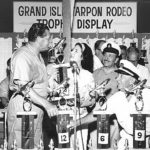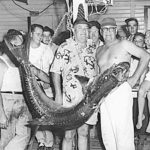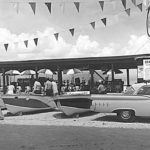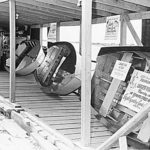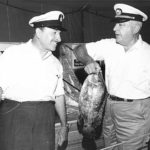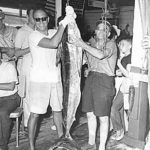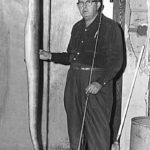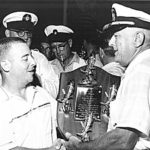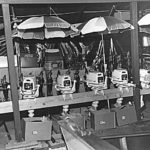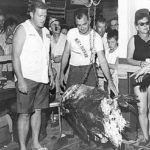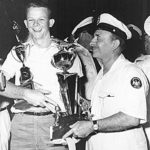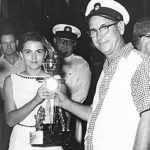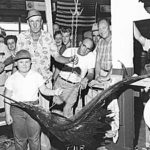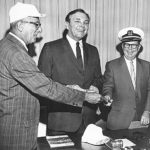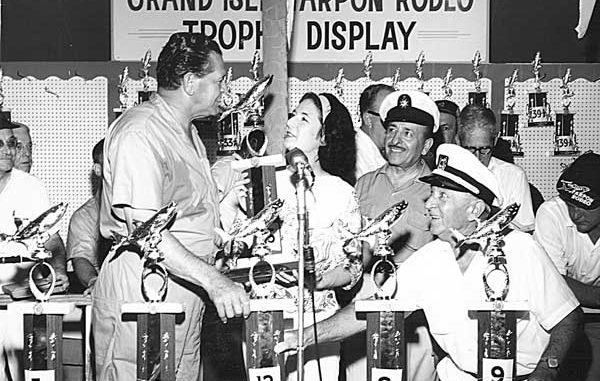
The roots of this annual event run deep.
For only the fourth time in 82 years the International Grand Isle Tarpon Rodeo has been cancelled. Its cancellation leaves a void in many saltwater anglers that will be hard to fill. The rodeo is the culmination of summer.
In its place, rodeo organizers will put on the “Island Aid Concert” on July 23, 24 and 25. Even without the fishing competition, the concert will help those who love the island bridge the gap between rodeos.
Referring to the Grand Isle Tarpon Rodeo as the “grand-daddy of fishing rodeos” might be one of the most hackneyed phrases a writer can use about the event. But it’s hard to resist, even though the term has been in use since at least the 1960s. Calling what happens each July on the tiny barrier island simply a fishing competition is like calling Attila the Hun’s invasion of Europe a scouting trip.
It is a vigorous fishing competition, certainly the oldest in the Gulf States and likely in the entire United States. It’s also a party — a really big party. Liquid refreshments pour like rivers, and after all, being Louisiana, it’s a food feast. Everyone cooks!
And it’s a place to be seen-by everyone and with everyone. The mighty and proud mingle with the common and humble. The population of the 8½-mile long sliver of sand increases from 1,525 people to more than 25,000 for the three days of the rodeo each July. In 2009 more than 2,500 of the total were actually registered to fish in the rodeo.
The mists of legend have so enshrouded the real history of the event that its origins may be impossible to completely untangle. Even the official mathematics used by the event’s sponsors doesn’t add up.
Founded in 1928, ostensibly as an annual event, the organizers were touting the 1949 rodeo as the Seventeenth Grand Isle Tarpon Rodeo. Seventeen rodeos in 22 years can be explained by no rodeo being held in 1930 and then again during the World War ll years of 1942-1945.
Yet in 2009, 81 years after the event was founded, the rodeo was billed as the “88th Annual Grand Isle Tarpon Rodeo.” The event regained its four lost years plus seven more. The mysterious math that no one can explain adds to the event’s mystique.
Probably the best account of how the rodeo was founded comes from an article written by Hugh M. Wilkinson called “Silver Kings of Grand Isle” and published in the September, 1928 issue of the magazine “Louisiana Fur, Game and Fish.”
As the tale goes, Wilkinson caught two tarpon in August 1927, “under the walls of old Fort Livingston,” an abandoned 19th century coastal defense fort located on Grand Terre Island across Barataria Pass from Grand Isle. His catch inspired him to propose a tarpon fishing tournament to John Cletus Donovan Jr., a New Orleans businessman.
The competition was proposed to be held on Grand Isle, which Wilkinson poetically described as “… that beautiful island set like a green and gold jewel between the jade-hued waters of Barataria Bay and the deep blue of the gulf.” Donovan immediately agreed that his business, the Alker-Donovan Company, would sponsor the event, and the Grand Isle Tarpon Club was formed.
On Wednesday, Aug. 22, 1928, 11 yachts — Adco, Recess, Allancia, Pirate, Nan, Moonflower, Shepherdess, Enola, Nimrod, Sumac and Dixie Flyer — along with the Department of Conservation’s flagship, the Pelican, assembled at Grand Isle.
Participants in the first rodeo are listed by name: P. Louis Adams, George T. Barker, W. C. Bembow, Percy S. Benedict, federal district attorney Wayne G. Borah, W.A. Broussard, Martin Burke, I.J. Cahill, A. Miles Coe, Ralston Cole, John C. Donovan, Jr., Alex Dorr, Sidney Fredericks, Franz Hinderman, W. Hoehn, Fred Lemieux, Jr., Jasper Lemieux, J.A. McKee, E.H. Macdowell, Leo A. Marrero, W.F. Marrero, Henry Miller, Tony Monteleone, Elvyn M. Moore, Chief Justice Charles A. O’Neill, J. O’Pry, Shepherd Perrin, Ed Phillips, Jules Randon, H.W. Robinson, Herbert Rueff, C.L. Sawyer, B.S. Strader, Malcolm Taylor, Bob Toye, Dr. Tucker, Oscar Turlington, Henry Verlander, Phil M. Warren, George Wiegand, Hugh M. Wilkinson and Carl Woodward.
The vast majority were New Orleanians.
Sam W. Taylor, publisher of “Louisiana Fur, Game and Fish” attended as a guest on the Pelican. The judges for the rodeo were Roger Howell of the Alker-Donovan Company fishing department, Alfred Danziger, president of the Young Men’s Business Club of New Orleans, and Horace Wilkinson, a member of the Louisiana Legislature.
It was a high-toned affair.
Fishing began at sunrise Thursday, and immediately produced a 103-pound silver king by Leo A. Marrero. The catch would be eclipsed several times, but won for Marrero the Alfred Danziger Cup for the first tarpon landed. Four more tarpon were taken the first day, a pair of 57-pounders by Carl A. Woodward and W.A. Broussard and a big 107-pound fish by C.L. Sawyer.
The latter fish was topped the second day by Wayne G. Borah with a tarpon of 109½ pounds, which in turn got clobbered by a monster caught by Elvyn M. Moore. Wilkinson described the fish as “exactly 129½ pounds of molten silver, poured into a mould of one of the most magnificent tarpon ever landed with a rod and reel in Louisiana, six feet five and a half inches from jaw to tail.”
The catch won the Grand Isle Tarpon Trophy for 1928.
Another “catch” made the first day began the string of colorful tales and lore associated with the Grand Isle Tarpon Rodeo to this day. George T. Barker, a guest on Horace Wilkinson’s houseboat, the Ladyfisher, brought in a pair of tarpon weighing 61 and 72 pounds. He told the committee that while fishing in the pass for “red-fish with two hooks on his line,” he hooked a double and landed them simultaneously.
No matter how improbable that sounded, Barker was awarded the Lake Hermitage Highway Cup for the greatest number of tarpon caught by a contestant and the Rigaud Hotel Cup for the greatest poundage.
Moore’s large tarpon was deemed unbeatable, and instead of fishing on Saturday, the final day of the rodeo, the contestants spent the day sightseeing and surf bathing. One final award, the Ludwig Hotel Cup (they had a lot of cups in those days), a consolation prize, was awarded to Charles A. O’Neill.
The report on the first rodeo would not have been complete without a culinary note. The contestants of the first rodeo dined on a 117-pound jewfish (goliath grouper) caught by W. Hoehn.
Following the rodeo, the Grand Isle Tarpon Club hosted the first of many formal New Orleans banquets that it would hold over the decades to present the trophies to their winners. The event was followed by a formalization of the club, and plans were made to hold a Grand Isle Tarpon Rodeo in August of each year.
While Grand Isle Tarpon Rodeos were certainly held on a regular basis after 1928, very little written material or photographs of the events can be found until 1946. Even the names of the presidents of the organization are unavailable.
According to Paul Candies, who functions as secretary for the Council of Past Presidents that now oversees the rodeo, a substantial amount of historical information on the rodeo was sent to Grand Isle for storage to be put in a new library being built on the island. Hurricane Katrina destroyed these when it inundated the island in 2005.
The rodeo definitely grew in glamour and attendance. In pre-rodeo publicity in 1949, Urban C. Wilkinson, General Chairman for Grand Isle Tarpon Rodeo, Inc., asked, “Why do Europe with Grand Isle at your door?”
The event had already grown beyond just a fishing contest. Wilkinson noted it as “ … a big ‘blow out’ with music and abundant eats.”
Rules of the rodeo still limited fishing to waters from Four Bayou Pass in the east to Caminada Pass in the west, north to Middle Banks and south to 25 miles offshore. But fish species eligible for competition had been expanded beyond tarpon to include jewfish, tripletail, cobia, bonito, jackfish, sheepshead, dolphin, Spanish mackerel, king mackerel, redfish and speckled trout.
Six officers and 14 committees oversaw the 1949 rodeo.
By 1951, the largesse of prizes offered to category winners was staggering, including among other things a 1951 Plymouth four-door sedan, a 32-piece silver set, 17 rods and reels, tools, a savings bond, three sets of automobile tires, a lawnmower, eight outboard motors, a .22 caliber rifle, an aquaplane, deck chairs, a fishing suit and oodles of trophies.
That same year attendance was listed at 1,434 people coming from 87 Louisiana towns and cities and 13 “foreign states” such as Arkansas, Mississippi and Texas.
The richness of the rodeo’s prizes ultimately led to their own downfall, according to Candies. Some people would do almost anything to win. The solid silver bowl given as the biggest trophy was worth over $500, a not inconsiderable sum in the late 1950s.
Rumors existed of net-caught fish being added to the board, and a local politician held a tarpon caught so long before the official dates of the rodeo that the hook tore out of its deteriorating mouth during weigh-in. Consequently, in the early 1960s, the decision was made to no longer give prizes of significant value. They were too tempting, and policing was too difficult.
A colorful chapter had ended.
A substantially later casualty was the spearfishing division. According to rodeo planners, spearfishermen seemed to have only one person on the dive boat register for the rodeo and then having everyone on the boat put their catches under the name of one person.
But the rodeo continued to expand. In 1967, the Grand Isle Tarpon Rodeo Inc. listed 31 officers, including 16 vice presidents, as well as an admiral of the fleet and two fleet surgeons. Twenty-one committees carried out the planning and execution functions of the rodeo. Rodeo rules had been modified by this time to allow fish taken from all coastal waters of Louisiana to be entered in the rodeo.
In spite of increasing sophistication, touches of the old rodeo’s charm still existed. The 1967 rodeo program provided interesting bits of information to accompany the crude illustrations of the 26 species of fish eligible for competition.
Barracuda were described as being “… capable of moving from a seemingly motionless position to the speed of a bullet in a matter of seconds.” The entry for bluefish cautions, “A warning to anglers! Keep hands and fingers clear of its mouth when degouging the hook.”
Fishermen were cautioned about sea catfish, as well. “It’s capable of throwing its barbs when least expected.” Culinary advice was also offered. “The bonito is a ‘blood fish’ with an oily skin.”
Even anatomical observations were made. The entry for sheepshead included “Most perfectly formed teeth of any fish.”
By 1989, a council of past presidents had been added to what was now known as the International Grand Isle Tarpon Rodeo Inc. The number of committees had expanded to 31. Eligible fish for the rodeo had been increased to 29 species, divided into a Big Game Division and a Shoreline Division.
By 2009, administration of the International Grand Isle Tarpon Rodeo had been streamlined. Planning was conducted by the Council of Past Presidents, and the number of officers had been reduced. Eleven committees handled execution of the massive event.
Twenty-nine species of fish were still eligible for competition, but were now divided into three divisions, Big Game, Shoreline and Inside. A Children’s Division had been added, as had a Big Game Tag & Release Division.
The increasing sophistication of the effort is seen most clearly in the program for the rodeo. No longer is it a simple reproduction filled with line drawings. The 2009 program is a full-sized, slick and polished, professionally done magazine of 123 pages, dripping in color.
The author wishes to acknowledge the contributions of three people who were essential for the production of this piece: Bob Dennie, formerly of the Louisiana Department of Wildlife and Fisheries. Paul Candies of Otto Candies, LLC and Chief Deputy Robert “Bud” Dill of the Lafourche Parish Sheriff’s
Office.
